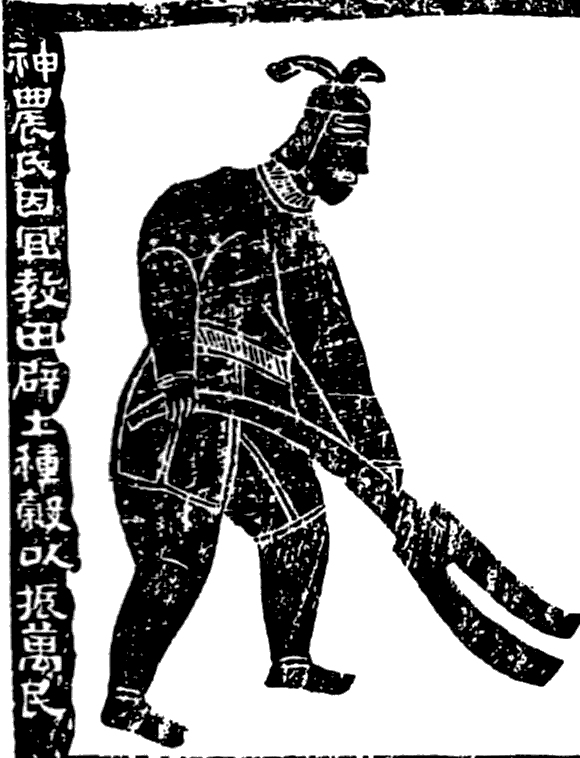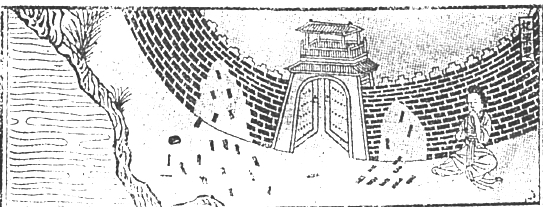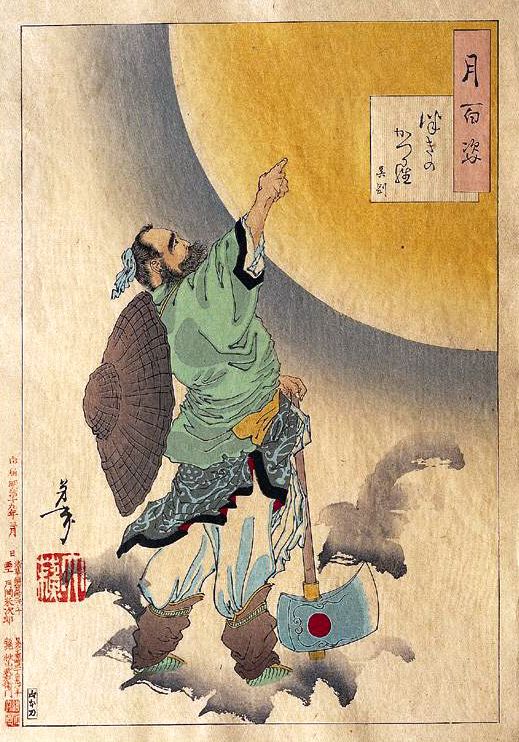|
Chinese Mythology
Chinese mythology () is mythology that has been passed down in oral form or recorded in literature throughout the area now known as Greater China. Chinese mythology encompasses a diverse array of myths derived from regional and cultural traditions. Populated with engaging narratives featuring extraordinary individuals and beings endowed with magical powers, these stories often unfold in fantastical mythological realms or historical epochs. Similar to numerous other mythologies, Chinese mythology has historically been regarded, at least partially, as a factual record of the past. Along with Chinese folklore, Chinese mythology forms an important part of Chinese folk religion and Taoism, especially older popular forms of it. Many narratives recounting characters and events from ancient times exhibit a dual tradition: one that presents a more historicized or euhemerized interpretation, and another that offers a more mythological perspective. Numerous myths delve into the creation ... [...More Info...] [...Related Items...] OR: [Wikipedia] [Google] [Baidu] [Amazon] |
Shennong
Shennong ( zh, c=神農, p=Shénnóng), variously translated as "Divine Farmer" or "Divine Husbandman", born , was a mythological Chinese ruler known as the first Yan Emperor who has become a deity in Chinese and Vietnamese folk religion. He is venerated as a culture hero in China and Vietnam. In Vietnamese, he is referred to as . Shennong has at times been counted amongst the Three Sovereigns (also known as "Three Kings" or "Three Patrons"), a group of ancient deities or deified kings of prehistoric China. Shennong has been thought to have taught the ancient Chinese not only their practices of agriculture, but also the use of herbal medicine. Shennong was credited with various inventions: these include the hoe, plow (both style and the plowshare), axe, digging wells, agricultural irrigation, preserving stored seeds by using boiled horse urine (to ward off the borers), trade, commerce, money, the weekly farmers market, the Chinese calendar (especially the division into th ... [...More Info...] [...Related Items...] OR: [Wikipedia] [Google] [Baidu] [Amazon] |
Longmen (mythology)
In Chinese mythology, ''Longmen'' ( "Dragon Gate") is located at the top of a waterfall cascading from a legendary mountain. The legend states that while many carp swim upstream against the river's strong current, few are capable or brave enough for the final leap over the waterfall. If a carp successfully makes the jump, it is transformed into a powerful Chinese dragon, dragon. The legend is so famous that throughout China, a common saying is that "a student facing his examinations is like a carp attempting to leap the Dragon Gate." Legends According to tradition, a carp that could swim upstream and then leap the falls of the Yellow River at Dragon Gate (''Longmen'') would be transformed into a dragon. This motif symbolizes success in the Imperial examination, civil service examinations. The Dragon Gate is located at the border of Shanxi and Shaanxi where the Yellow River flows through a cleft in the Mount Longmen (Shanxi), Longmen mountains, supposedly made by Yu the Great, w ... [...More Info...] [...Related Items...] OR: [Wikipedia] [Google] [Baidu] [Amazon] |
Chinese Zodiac
The Chinese zodiac is a traditional classification scheme based on the Chinese calendar that assigns an animal and its reputed attributes to each year in a repeating twelve-year (or duodenary) cycle. The zodiac is very important in traditional Chinese culture and exists as a reflection of Chinese philosophy and Chinese culture, culture. Chinese folkways held that one's personality is related to the attributes of their zodiac animal. Originating from China, the zodiac and its variations remain popular in many East Asian and Southeast Asian Sovereign state, countries, such as Japan, South Korea, Vietnam, Singapore, Nepal, Bhutan, Cambodia, and Thailand. Identifying this scheme as a "''zodiac''" reflects superficial similarities to the western astrology, Western zodiac: both divide time cycles into twelve parts, label the majority of those parts with animals, and are used to ascribe a person's personality or events in their life to the person's particular relationship to the cycle. ... [...More Info...] [...Related Items...] OR: [Wikipedia] [Google] [Baidu] [Amazon] |
New Year's Eve
In the Gregorian calendar, New Year's Eve refers to the evening, or commonly the entire day, of the last day of the year, 31 December, also known as Old Year's Day. In many countries, New Year's Eve is celebrated with dancing, eating, drinking, and watching or lighting fireworks. Many Christians attend a watchnight service to mark the occasion. New Year's Eve celebrations generally continue into New Year's Day, January 1, 1 January, past midnight. The local time zone determines the advent of the New Year; the first places to welcome the New Year are west of the International Date Line: the Line Islands (part of Kiribati), Samoa and Tonga, in the Pacific Ocean. In contrast, American Samoa, Baker Island and Howland Island (part of the United States Minor Outlying Islands) are among the last. By region Africa Algeria In Algeria, New Year's Eve is usually celebrated with family and friends. In the largest cities, there are fireworks at midnight. The Martyrs' Memorial, Algiers, Ma ... [...More Info...] [...Related Items...] OR: [Wikipedia] [Google] [Baidu] [Amazon] |
King Mu Of Zhou
King Mu of Zhou (), personal name Ji Man, was the fifth Chinese sovereign, king of the Zhou dynasty of China. The dates of his reign are 976–922 BC or 956–918 BC. Life King Mu came to the throne after his father King Zhao of Zhou, King Zhao’s death during the Zhou–Chu War, Zhou-Chu war. King Mu was perhaps the most pivotal king of the Zhou dynasty, reigning nearly 55 years, from ca. 976 BC to ca. 922 BC. Mu was more ambitious than wise, yet he was able to introduce reforms that changed the nature of the Zhou government, transforming it from a hereditary system to one that was based on merit and knowledge of administrative skills. Mu tried to stamp out invaders in the western part of China and ultimately expand Zhou’s influence to the east. In the height of his passion for conquests, he led an immense army against the Quanrong, who inhabited the western part of China. His travels allowed him to contact many tribes and swayed them to either join under the Zhou banner or ... [...More Info...] [...Related Items...] OR: [Wikipedia] [Google] [Baidu] [Amazon] |
Butterfly Lovers
The Butterfly Lovers is a Chinese legend centered around the tragic romance between Liang Shanbo () and Zhu Yingtai (), whose names form the Chinese title of the story. The title is often abbreviated as Liang Zhu (). The story was selected as one of China's Four Great Folktales by the "Folklore Movement" in the 1920s—the others being the Legend of the White Snake (''Baishezhuan''), Lady Meng Jiang, and The Cowherd and the Weaving Maid (''Niulang Zhinü''). Six cities in China collaborated in 2004 on a formal application for the Proclamation of Masterpieces of the Oral and Intangible Heritage of Humanity on the legend at UNESCO, submitted in 2006 through the Chinese Ministry of Culture. Legend The legend of Liang Shanbo and Zhu Yingtai is set in the Eastern Jin dynasty (266–420 AD). Zhu Yingtai is the ninth child and only daughter of the wealthy Zhu family of Shangyu, Zhejiang. Although women are traditionally discouraged from taking up scholarly pursuits, Zhu manag ... [...More Info...] [...Related Items...] OR: [Wikipedia] [Google] [Baidu] [Amazon] |
Lady Meng Jiang
Lady Meng Jiang or Meng Jiang Nü () is a Chinese tale with many variations. Later versions are set in the Qin dynasty, when Lady Meng Jiang's husband was pressed into service by imperial officials and sent as Corvee, corvee labor to build the Great Wall of China. Lady Meng Jiang heard nothing after his departure, so she set out to bring him winter clothes. Unfortunately, by the time she reached the Great Wall, her husband had already died. Hearing the bad news, she wept so bitterly that a part of the Great Wall collapsed, revealing his bones. The story is now counted as one of China's Four Great Folktales, the others being the Legend of the White Snake (''Baishezhuan''), Butterfly Lovers, and The The Weaver Girl and the Cowherd, Cowherd and the Weaving Maid (''Niulang Zhinü''). Chinese folklorists in the early 20th century discovered that the legend existed in many forms and genres and evolved over the last 2,000 years. The section of the Great Wall that was toppled in the leg ... [...More Info...] [...Related Items...] OR: [Wikipedia] [Google] [Baidu] [Amazon] |
Wu Gang
Wu Gang (), formerly romanized as Wu Kang and also known as Wu Zhi in some sources,Eberhard, Wolfram. ''Dictionary of Chinese Symbols: Hidden Symbols in Chinese Life and Thought''pp. 76 ff Routledge & Kegan Paul (London), 2013. Accessed 12 November 2013. is a figure in traditional Chinese folklore and religion. He is known for endlessly cutting down a self-healing osmanthus tree on the Moon, a divine punishment which has led to his description as the Chinese Sisyphus.Brendon, Juliet & al. ''The Moon Year: A Record of Chinese Customs and Festivals''p. 410 Kelly & Walsh, 1927. Reprinted Routledge ( Abingdon), 2011. Accessed 13 November 2013. In modern Chinese, the '' chengyu'' "Wu Gang chopping the tree" (; ''wúgāng-fáguì'') is used to describe any endless toil. The specific reason for his situation has varied in the sources, but Wu Gang's story dates back to at least the Tang dynasty. Legend Origins An origin myth for the lunar phases was that a great forest or great tree g ... [...More Info...] [...Related Items...] OR: [Wikipedia] [Google] [Baidu] [Amazon] |
Hou Yi
Hou Yi () is a mythological Chinese archer. He was also known as Shen Yi and simply as Yi (). He is also typically given the title of "Lord Archer". He is sometimes portrayed as a god of archery or a ''xian'' descended from heaven to aid mankind. Other times, he is portrayed as either simply half-divine or fully mortal. His wife, Chang'e, is one of the lunar deities. Lore In Chinese mythology, there were originally 10 suns; in some forms of this myth they are the sons or grandsons of the Jade Emperor. Initially, the 10 suns would cross the sky one by one, but one day the 10 suns decided to come out all at once so that they could play with each other, and scorched the earth. Hou Yi was tasked by the mythical Emperor Yao—in some versions, the Jade Emperor—to rein in the suns. Hou Yi first tried to reason with the suns. When that did not work, he then pretended to shoot at them with his bow to intimidate them. When the suns again refused to heed Hou Yi's warnings, he began to ... [...More Info...] [...Related Items...] OR: [Wikipedia] [Google] [Baidu] [Amazon] |
Chang'e
Chang'e ( ; ), originally known as Heng'e (), is the goddess of the Moon and wife of Hou Yi, the great archer. Renowned for her beauty, Chang'e is also known for her ascending to the Moon with her pet Yu Tu, the Moon Rabbit and living in the Moon Palace (). She is one of the major goddesses in Chinese mythology, Chinese folk religion, Chinese Buddhism, Confucianism, and Taoism. In modern times, Chang'e is the namesake of the Chinese Lunar Exploration Program. Origins and descriptions Chang'e first appeared in '' Guicang'', a divination text written during the Zhou Dynasty (1046 BC – 256 BC). From the few preserved fragments of the text, it mentions "Yi shoots the ten Suns", and "Chang'e ascending to the moon." Chang'e—originally named —was renamed to avoid the taboo on sharing names with a deceased emperor, in this case, Liu Heng, an emperor from Han Dynasty. Many Chinese poems are written around the theme of Chang'e and the moon. In pre-Qin Dynasty (before 221 BC), ... [...More Info...] [...Related Items...] OR: [Wikipedia] [Google] [Baidu] [Amazon] |
The Cowherd And The Weaver Girl
''The Cowherd and the Weaver Girl'' are characters found in Chinese mythology and appear eponymously in a romantic Chinese folk tale. The story tells of the romance between Zhinü (; the weaver girl, symbolized by the star Vega) and Niulang (; the cowherd, symbolized by the star Altair). Despite their love for each other, their romance was forbidden, and thus they were banished to opposite sides of the heavenly river (symbolizing the Milky Way). Once a year, on the seventh day of the seventh lunar month, a flock of magpies would form a bridge to reunite the lovers for a single day. Though there are many variations of the story, the earliest-known reference to this famous myth dates back to a poem from the Classic of Poetry from over 2600 years ago: ''The Cowherd and the Weaver Girl'' originated from people’s worship of natural celestial phenomena, and later developed into the Qiqiao or Qixi Festival since the Han Dynasty. It has also been celebrated as the Tanabata fest ... [...More Info...] [...Related Items...] OR: [Wikipedia] [Google] [Baidu] [Amazon] |








